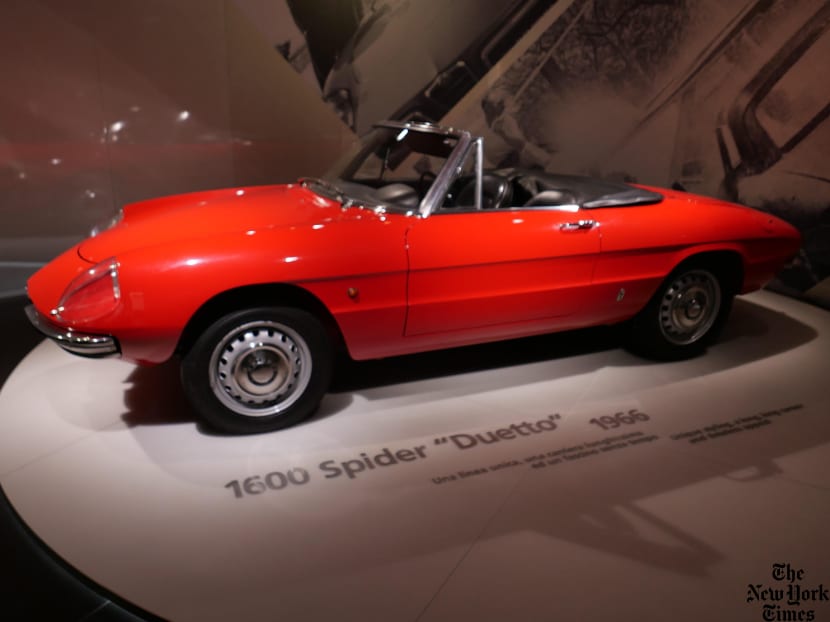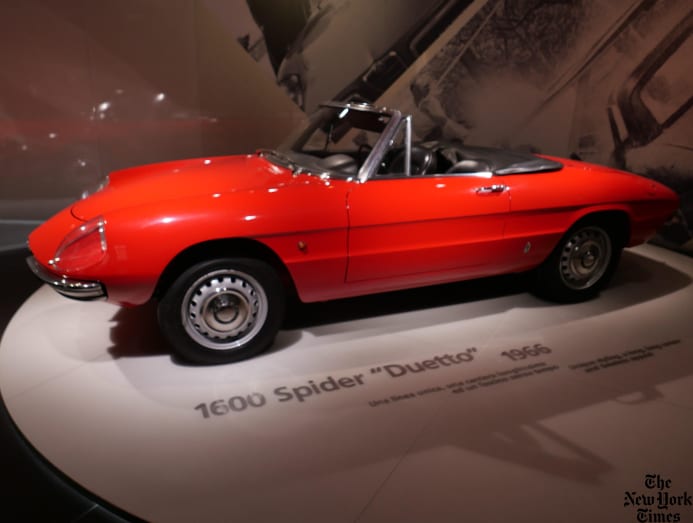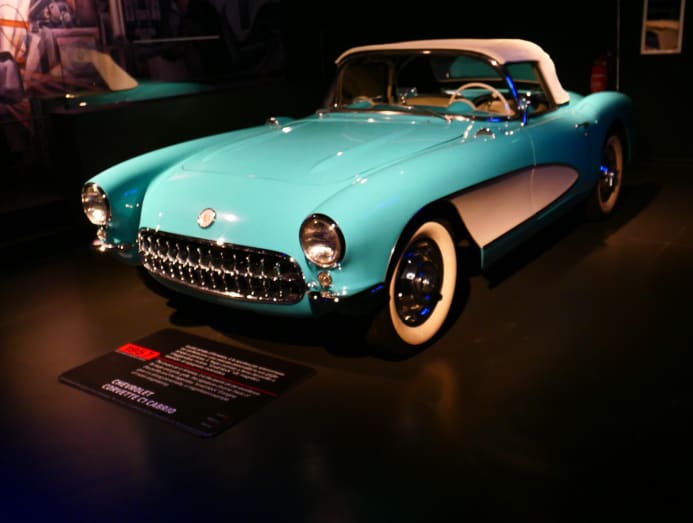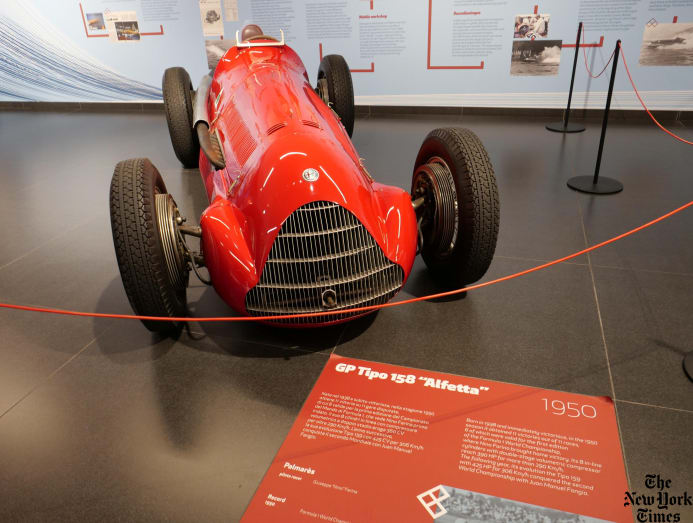Travelling to Italy? For car fanatics, visiting these 3 museums is a must
Advertisement
Travel
Travelling to Italy? For car fanatics, visiting these 3 museums is a must
Ferrari, Maserati and Lamborghini get all the love. But this New York Times writer visited Milan and Turin in search of automotive greatness beyond the usual suspects.

The 1600 Alfa Spider Duetto driven by Dustin Hoffman in The Graduate, at Alfa Romeo's museum near Milan. Alfa produced the model for more 25 years. (Photo: The New York Fourth dimension/Stephen Williams)
Quickly now: What single word comes to listen when the subject of Italian automobile museums comes upwardly at a cocktail party?
Ferrari. Of course. Or perhaps Maserati. Or maybe Lamborghini. Simply for the side by side thousand words or so, put aside those human knee-jerk responses. For now, let'southward think out of the machine museum box.
During a recent visit to the Italian n, I shuttled betwixt Milan and Turin in search of some automotive greatness across what is usually found on tourists' agendas. Find it I did, at the "other" museums, one celebrating the history of Alfa Romeo and the second at the home of Fiat in the truthful heartland of the Italian auto industry for more a century.
Y'all want red cars? Alfa has rosso in more than a few stunning shades. Engineering science? Start with Leonardo da Vinci's cocky-propelled motorcar from 1478. No time for Porsches? Practiced. You volition non notice any here.
Hither is a closer look at a pair of destinations that both enthusiasts and un-car people can capeesh, equally well as a short stop at Italy's iconic tire producer, Pirelli.

MUSEO STORICO ALFA ROMEO, Arese. Fix in Arese, a Milan suburb, the Museo Storico is a romantic deep dive into 111 years of Italian history, as told through the prism of one of its more than fascinating and indelible brands. While the themes of the museum's layout – Timeline, Beauty and Speed – offering a precise, thoughtful assessment of Alfa'due south importance to Italy and its manufacture, the presence of and then much gorgeous sail metallic in a single building is enough to excite passions.
The company was early "to realise that a museum could be an asset for marketing," said Lorenzo Ardizio, the museum's manager. Initially, it was opened in 1976 merely to guests and journalists, but under Sergio Marchionne's guidance, Storico was refurbished and reopened in 2022 for the introduction of the Giulia sedan. The previous year, Marchionne had engineered the merger of Fiat Chrysler Automobiles. (Fiat had taken over Alfa in 1986.) FCA is at present part of the Stellantis group. Yes, it gets complicated.
Regarding the Storico, Ardizio said, "The idea was to create something to attract a much wider public, for people who might not be particularly interested in automobiles." This is a recurring theme for virtually automotive museums.
All the usual high-tech goodies of 21st-century brandish formats are here: Multimedia panels, exotic lighting, a giant video wall that traces some of Alfa'south elegiac performances in motorsports. The modest 1.5-liter Alfettas won the first Formula 1 globe championship in 1950, coming in first, second and third in that Grand Prix flavour. Alfa'due south second-place driver was Juan Manuel Fangio, considered amid the nearly brilliant race drivers e'er. The results were reasons to cheer in this race-car-mad nation, whose auto industry had been decimated in the mid-1940s by the retreating Germans and the advancing Allies.
It was the meaty Giulietta coupe, with a design influenced by Raymond Loewy, that reignited Alfa in showrooms in 1954. Amidst the 70 or so cars on permanent display in the proper museum (there is besides a closed-to-the-public "workshop" with many historic Alfas), the tidy Giulietta is an awfully precious showoff. Prompted by its success, Ardizio said, the company blossomed after World War II, edifice up to 1,000 cars a 24-hour interval not so long subsequently it had been turning out only 300 each twelvemonth.

Recognise that red convertible over there? Many moviegoers will: It is the 1600 Spider Duetto that Dustin Hoffman drove over the Bay Bridge in The Graduate. According to our guide at the Storico, the encyclopedic Eleonora Ventura, the classic 1966 model, designed by Pininfarina's studio, was "booked" – actually, so were a dark-green i and a white one – on the deck of a luxury liner sailing from Genoa to New York.
"The ship stopped in Cannes at the film festival and took on some actors and VIPs who had the opportunity to drive them on the deck on the trip to New York," she said. This Alfa – a model that was produced for 28 years – after had "flake parts" in a number of films.
Information technology is worth pointing out that almost all the information displayed beside the cars and in the videos is in English. Ardizio estimates that more than than 130,000 visitors passed though the Storico in 2020.

THE NATIONAL AUTOMOBILE MUSEUM, Turin. For American visitors to Italy, Turin is oftentimes an reconsideration, overshadowed by itineraries heavy on Rome-Florence-Milan-Venice. But for automobile cognoscenti, Turin, Italian republic'south first capital city before Rome, has a rich history: Lancia, IVECO, Pininfarina, Bertone, Giugiaro and Ghia, magical names in Italian design lore, were all founded here, congenital around the habitation of Turin'south industrial megastar, Fiat.
Non surprisingly, the Museo Nazionale dell'Motorcar is among the world's largest dedicated to the car. With legacies so rich built effectually a collection of about 200 models dating from 1854, one ought to receive a bachelor'due south degree in history after spending an intense few hours here. Founded in 1933, the museum was renovated in 2022 and attracts nigh 200,000 visitors annually, well-nigh half of them from exterior Italy, said our guide, Felipe Vergara.
The Museo Nazionale dell'Automobile is among the world's largest dedicated to the automobile.
Science melds with sport at the museum. One display highlights Formula 1 championship cars driven by Fangio and Michael Schumacher; another lights up the 1854 Bordino steam railroad vehicle that wowed the Turinese as it cruised sans horsepower through the city's narrow streets.
Vergara becomes blithe too virtually the notably unaerodynamic Italian republic, a 40-horsepower monster that competed in the notorious 1907 Peking-to-Paris motorcar race. The car on display, browbeaten up and war-torn, is inspiring. There are removable mudguards for water crossings, oversize tanks for gasoline.
"The idea was, is anybody crazy plenty to become from Peking to Paris, a trip of 16,000 kilometers?" Vergara asked. "Five teams showed upward."
The Gobi Desert and Siberia were only ii of the obstacles that faced the drivers. Prince Scipione Borghese, a military man, was backside the wheel of the Italia. He rolled the Italy into Paris later 61 days; the second-place automobile arrived three weeks afterwards. News coverage was prodigious; those who had dismissed the automobile every bit a fad were humbled.
The museum, for skillful reason, is inextricably tied to Fiat (Fabbrica Italiana di Automobile Torino, not "Fix it again, Tony") and its brilliant simply politically divisive founder, Giovanni Agnelli. (At ane point he was aligned with sometime Prime Minister Benito Mussolini and at another was put on trial for fraud.)
More than than in one case in the last 120 years, Fiat has tipped toward defalcation – the brand is practically invisible now in the U.s.a. – just its cars are ubiquitous in Turin and at this museum. Particularly notable is the startling scarlet-and-white Turbina from 1954, powered by a gas turbine – in other words, a jet engine. The concept never made series product, but it did make an unforgettable whine at machine shows.
Overall, the museum'south intelligent layout – a chronological journey over several floors – offers a visual narrative of the machine, from the very beginning: da Vinci's windup, jump-loaded "motorcar" to the touchstone Jaguars and Ferraris of the present day.
"People come up in and say, 'I wasn't interested in cars,' before they got here," Vergara said, "and afterward, they realise how interesting it gets."

PIRELLI FOUNDATION MUSEUM, Milan. Who knew that tires could foster a museum? Only, rather than canvas metallic and fuel injection, the Fondazione Pirelli in the center of Milan is sustained by safe.
An Italian institution, Pirelli traces its influence though decades (it turns 150 next year) and beyond just tires, although motorsports fans are familiar with the brand because Pirellis are the merely tires allowed in Formula 1 racing. The displays at the foundation – including paintings, films and Pirelli's collection of ultrasophisticated advertizing posters – emphasise the visitor'due south piece of work to propagate fine art and civilisation among its workforce. (In 2017, the Orchestra da Photographic camera Italiana performed a concert inside a Pirelli plant.)
There is pride of identify here as well for the notorious Pirelli Calendar. The full-color, oversize calendars – called "the Cal" – became cult items in the 1960s and '70s, featuring glamorous women in diverse states of undress. When easy nudity fell out of favor later, the calendars became more than art and less Playboy.
There is also an extensive annal of historical documents and articles if your interest in Pirelli is more academic. Students and researchers are allowed access by arrangement.
By Stephen Williams © New York Times Company
This article originally appeared in The New York Times.
Contempo Searches
Trending Topics
gutierrezpokenderyind.blogspot.com
Source: https://cnalifestyle.channelnewsasia.com/travel/travelling-italy-car-fanatics-visiting-these-3-museums-must-286281

0 Response to "Travelling to Italy? For car fanatics, visiting these 3 museums is a must"
Post a Comment